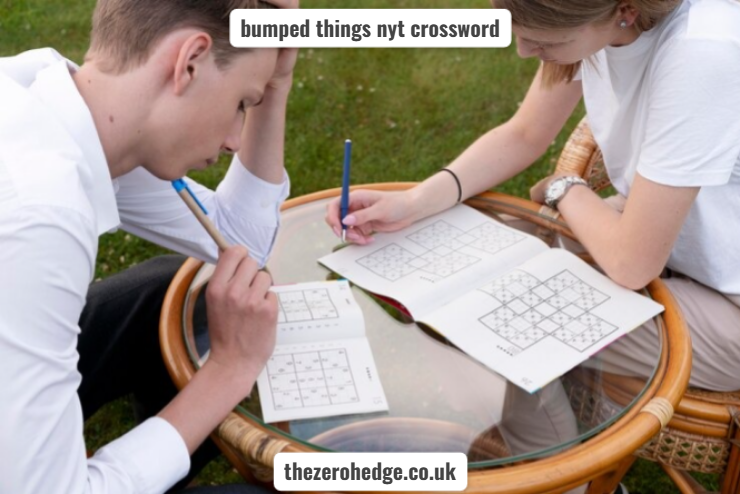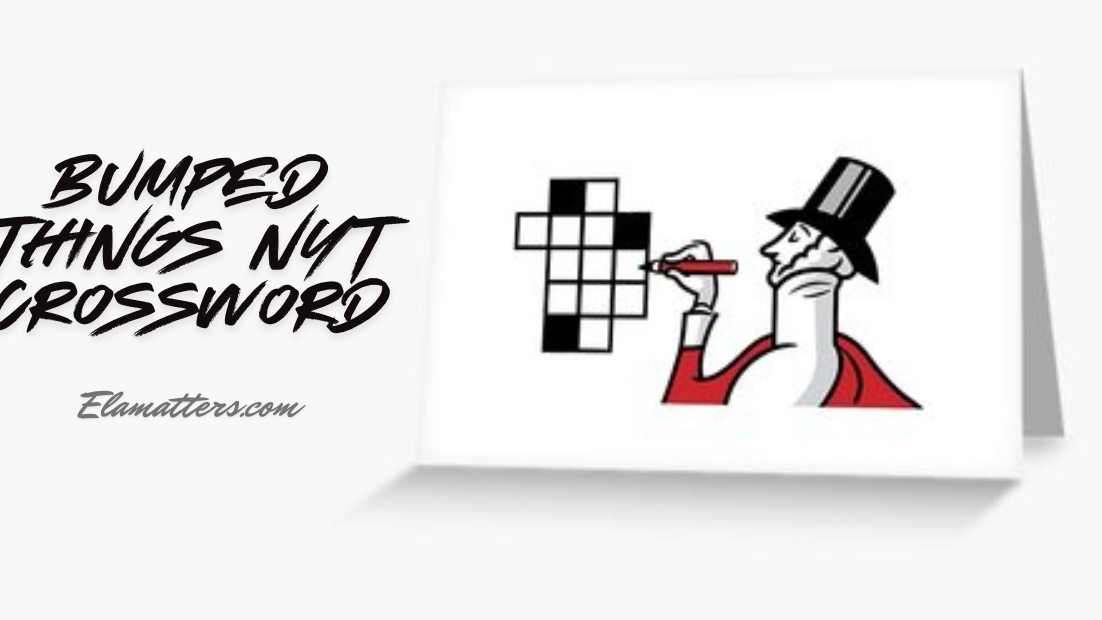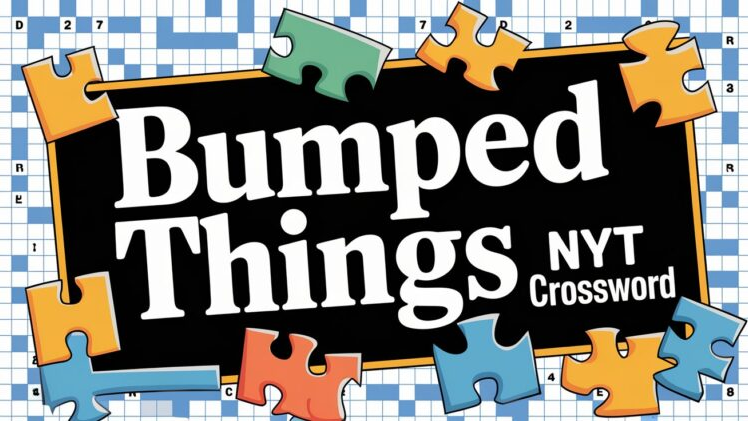
Crossword puzzles have long been a favorite pastime for many. Whether you’re solving one as a daily ritual or occasionally diving into a challenging puzzle, the satisfaction of filling in the last square is undeniable. Among the many famous crossword puzzle varieties, the New York Times crossword is often regarded as one of the toughest. Within this world of intricate wordplay, you might have come across a term like “bumped things” in a NYT crossword, and wondered what it means or how it fits into the puzzle. This article delves into understanding “bumped things” in the context of crossword puzzles, specifically NYT crosswords, and explores its significance, origins, and some strategies for solving puzzles involving such terms.
What Does “Bumped Things” Mean in Crossword Puzzles?
In crossword puzzles, particularly those found in the New York Times, “bumped things” is a phrase that frequently appears as part of the cryptic clues or answers. It refers to certain elements in a crossword that get moved or altered during the puzzle-solving process. “Bumped” here implies an interaction or a shift that occurs when filling in words in certain directions or in relation to each other.
For example, in the case of an across clue where a word may need to “bump” against a down clue, the letter where the two intersect becomes crucial to the solution. The term can also hint at certain crossword mechanics where letters from different clues influence each other, creating a “bump” effect.
The Mechanics Behind “Bumped Things”
When you tackle a crossword puzzle, particularly the New York Times crossword, you’re often faced with various types of clues, including straightforward ones, cryptic ones, and sometimes even misdirecting clues. “Bumped things” often involve such mechanics, where words are designed to overlap or shift.
Here’s an example:
- Clue: “Something that bumps into you”
- Answer: “Jostle”
In this case, “bumped” is used synonymously with “jostle,” and the word “bumped” gives you a hint about the movement or interaction between the letters or the way the clues fit together.
Why “Bumped Things” are Important in Crosswords
“Bumped things” are critical in crossword puzzles because they often determine how well the clues intersect and how smoothly the puzzle flows. This dynamic can make a puzzle more challenging or interesting. In NYT puzzles, especially in the later days of the week, you will find that these types of clues often become more intricate.

Examples of “Bumped Things” in the New York Times Crossword
- Clue: “Where things can get bumped in a crowd”
- Answer: “Street”
- Answer: “Street”
In this case, “bumped” refers to the interaction that happens when people are in close quarters, such as on a street during a busy time.
- Clue: “An object that bumps into you unexpectedly”
- Answer: “Bumper”
- Answer: “Bumper”
Here, the word “bumped” directly connects to a common object—used for protection during collisions or unexpected impacts.
- Clue: “What happens when objects bump”
- Answer: “Collide”
- Answer: “Collide”
This example uses “bumped” in the sense of a collision, emphasizing the physical nature of the interaction.
How to Solve Puzzles with “Bumped Things” Clues
Solving crossword puzzles that contain “bumped things” clues can be tricky. Below are some strategies that can help you decode these types of puzzles more efficiently:
1. Think About Synonyms
Often, the term “bumped” will be used as a clue for a synonym like “jostle,” “collide,” or “knock.” Always be on the lookout for such synonyms when trying to solve the clue.
2. Look for Clue Connections
Many times, the answers to “bumped things” clues will overlap with other answers. This creates a situation where multiple clues share letters. Pay attention to how words might connect and lead you to a solution.
3. Consider Wordplay
Cryptic clues in the NYT crossword often use wordplay. The term “bumped” could be a hint to word rearrangements or anagram solutions. Look for ways to rearrange letters when you see “bumped.”
4. Use Cross-Checking
Ensure your answers fit with the other intersecting words. “Bumped things” clues often lead to words that interconnect, and the overlapping answers help verify your solution.
5. Practice
The more you practice, the better you’ll get at recognizing the patterns behind clues involving “bumped things.” Don’t be afraid to try different approaches and experiment with answers.
The Influence of “Bumped Things” on the Puzzle
The way clues and answers interact in crossword puzzles like the NYT crossword is both an art and a science. “Bumped things” serve as an excellent example of this interaction. In a crossword, this interaction isn’t just about the words fitting together physically; it’s about the intellectual engagement between clues and answers. “Bumped things” can sometimes make you reconsider how words are structured, forcing you to think outside the box and reconsider what you know about language.

How to Approach the New York Times Crossword
The NYT crossword has a reputation for being one of the toughest in the world. With its daily increasing difficulty, solving the crossword requires patience, practice, and a strategic approach. One of the best ways to approach the NYT crossword is to break it down into smaller sections, starting with the easier clues and progressively working your way up to the more difficult ones.
Additionally, solving puzzles with “bumped things” clues might require a different mindset. Instead of solely focusing on the individual clue, think about how the word fits into the larger context of the puzzle. Cross-checking your answers frequently and using a mix of trial and error will increase your chances of success.
Strategies for Advanced Crossword Solvers
For more advanced solvers, clues involving “bumped things” will likely represent some of the trickier elements of the NYT crossword. The NYT crossword evolves over the week, with the difficulty ramping up on Thursday and Friday, so be prepared for complex puzzles with more abstract clues.
Conclusion: The Art of Solving “Bumped Things” NYT Crosswords
Understanding “bumped things” in crossword puzzles isn’t just about knowing the word itself; it’s about understanding the relationship between clues, answers, and how they interconnect. These types of clues challenge solvers to think critically, apply synonyms, and experiment with wordplay. As you get more familiar with these kinds of puzzles, your ability to solve them quickly will improve, making your overall crossword-solving experience even more enjoyable. Remember, practice and patience are key!
FAQs
- What does “bumped things” mean in a crossword clue?
“Bumped things” often refers to objects or situations where something is physically jostled or collided with another thing. It can also refer to words that interact or “bump” into each other in a crossword grid. - How can I improve my ability to solve tricky crossword clues like “bumped things”?
Practice is essential. Additionally, focus on recognizing common synonyms for “bumped” and pay attention to how answers intersect in the puzzle. - Are “bumped things” clues only found in the New York Times crossword?
While the NYT crossword is known for incorporating such clues, many other crossword puzzles, including those in newspapers and apps, may also use this type of clue.



